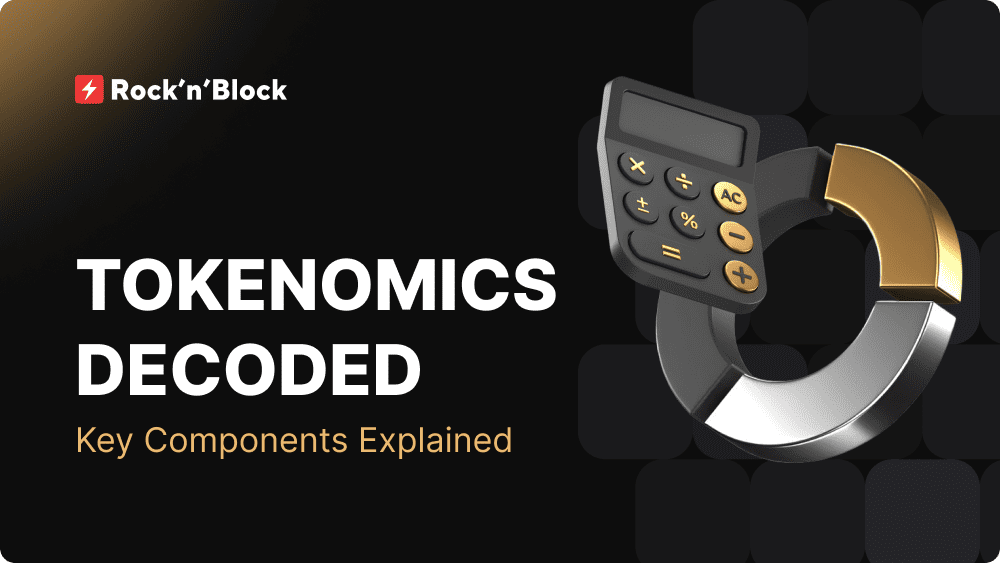Exploring Tokenomics: Key Components Unraveled
 RocknBlock
RocknBlock
Understanding tokenomics is essential for anyone involved in DeFi and crypto token development. This guide explains the basics of tokenomics, including its importance and key components. It aims to help you confidently navigate the complexities of tokenomics. Join us as we explore the mysteries of tokenomics and its role in driving innovation and shaping the future of finance in the digital age.
What Is Tokenomics?
Tokenomics is the combination of the words 'token' and 'economics'. It refers to the economic principles that govern the creation, distribution, and management of cryptocurrency tokens, as well as the organization of all related processes. It includes factors such as token supply, utility, distribution mechanisms, and the overall economic model underlying a particular cryptocurrency project.
🔥 Read the full version here!
Why Is Tokenomics Important For Your Project?
Tokenomics is crucial for crypto projects as it structures token development, distribution, and utilization. It's especially vital for DApps, ICOs, and DeFi protocols, serving as their economic foundation. Tokenomics incentivizes participation, ensures utility and value, and establishes governance. Understanding its benefits is key for successful DeFi projects, including:
1. Economic Model Design: Essential for creating a sustainable ecosystem that incentivizes growth and aligns stakeholders' interests.
2. Token Value and Utility: Determines token's value and demand through clear use cases, incentives, and benefits, attracting investors and users.
3. Funding and Capital Formation: Serves as the basis for fundraising, attracting investment, and supporting project development.
4. Community Building: Fosters loyalty and collaboration among users and contributors, nurturing project communities.
5. Sustainability: Ensures long-term project sustainability by supporting ongoing development and growth.
6. Market Competitiveness: Provides a competitive edge by offering attractive incentives and value propositions, positioning projects as market leaders.
Key Components of Tokenomics
Understanding the fundamentals of tokenomics is essential for grasping the intricacies of token economy. Let’s explore the key components of tokenomics that lay the foundation for crypto token development and ecosystem management.
Token Supply
In crypto token development, token supply refers to the total number of tokens in a cryptocurrency ecosystem, critical for valuation, inflation, deflation, and sustainability. Examples of token supply mechanisms include:
1. Fixed Supply: Tokens have a set limit, promoting scarcity.
2. Inflationary Supply: New tokens are continuously issued, incentivizing participation.
3. Deflationary Supply: Token supply decreases over time, often through burns, increasing scarcity and value.
4. Algorithmic Supply: Token supply adjusts based on rules, aiming for stability.
Token Distribution and Allocation
The token distribution and allocation establish the economic model for the DeFi project development. This includes deciding the initial number of tokens and how they will be distributed among stakeholders, such as team, investors, advisors, and the community. It also determines the distribution of tokens for different purposes, such as staking rewards, yield farming rewards, airdrops, marketing initiatives, strategic partnerships and so on.
These are just a few examples of token allocation tranches, and projects may incorporate other token distribution practices based on their objectives and economic models.
Vesting Schedules and Lock-up Periods
To ensure token stability and foster long-term dedication, projects may employ vesting schedules or lock-up periods for tokens allocated to team members, advisors, and early investors.
Vesting schedules regulate token release over time, incentivizing commitment and discouraging immediate selling. This promotes price stability and project sustainability.
Lock-up periods add further restrictions, preventing token transfers or sales for a set duration. Applied to founders and early investors, this aligns interests with long-term success, reducing speculation and market volatility.
Token Utility
Token utility refers to how a cryptocurrency token is used, its value proposition, and its functionality within its ecosystem. It's critical for driving token value and scarcity, directly impacting market demand. Without a clear utility model, a token is unlikely to be valuable, underscoring the importance of defining its role within the project's ecosystem.
In decentralized applications, tokens often serve as native currencies or utility tokens, providing access to platform features, services, or resources. Token utility can take various forms:
1. Access and Membership
2. Transaction Medium
3. Rewards and Incentives
4. Discounts and Benefits
5. Gaming and Virtual Worlds
6. Content Creation and Curation
7. Data Access and Marketplace
8. Governance and Voting Rights
Projects may incorporate multiple utility mechanisms to enhance their token's value proposition and incentivize user participation.
Common Pitfalls in Tokenomics
Poor tokenomics can signal project failure, with several factors serving as red flags for investors:
1. Massive Pump and Dumps: Disproportionate token allocations to early investors can lead to pump and dump schemes during pre-sales, harming newer investors. Scrutinizing token distribution is crucial before investing.
2. Unlimited Supply: While unlimited token supplies like Ethereum's can be justified by utility, adopting one without valid reasoning can indicate poor tokenomics. Arbitrary minting may benefit founders at investors' expense once the token gains value.
3. Lack of Actual Utility: Tokens without tangible purposes in the project's ecosystem are speculative assets vulnerable to market volatility. Projects lacking genuine utility struggle to maintain user engagement, hindering credibility and sustainability in the cryptocurrency landscape.
Is It Hard to Create Tokenomics?
Creating tokenomics can be a complex effort that requires a deep understanding of economic principles, market dynamics, and blockchain technology. Designing tokenomics that align with project goals, incentivize desired behaviors, and ensure long-term sustainability can be a challenging task. To effectively navigate these complexities, it is advisable to enlist the services of a robust and experienced tokenomics development company that specializes in blockchain and cryptocurrency solutions. These companies possess the expertise and resources to craft robust tokenomics models tailored to the unique requirements of each project.
Subscribe to my newsletter
Read articles from RocknBlock directly inside your inbox. Subscribe to the newsletter, and don't miss out.
Written by

RocknBlock
RocknBlock
Welcome to Rock'n'Block, where innovation meets security in the world of blockchain development. As a cutting-edge company, we specialize in crafting decentralized solutions that empower businesses with transparency and efficiency. Our expert team merges creativity with technology to build robust blockchain applications, ensuring our clients stay ahead in the digital revolution.